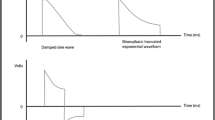Abstract
Introduction: A variety of factors, including the number of defibrillation electrodes and shocking capacitance, may influence the defibrillation efficacy of an implantable defibrillator system. Therefore, the purpose of this study was to compare the defibrillation energy requirement using a 125 uF two-electrode defibrillation system and a 90 uF three-electrode defibrillation system.
Methods and Results: The defibrillation energy requirements measured with both systems were compared in 26 consecutive patients. The two-electrode system used a single transvenous lead with two defibrillation coils in conjunction with a biphasic waveform from a 125 uF capacitor. The three-electrode system used the same transvenous lead, utilized a pectoral implantable defibrillator generator shell as a third electrode, and delivered the identical biphasic waveform from a 90 uF capacitor. The two-electrode system was associated with a higher defibrillation energy requirement (10.8±5.5 J) than was the three-electrode system (8.9±6.7 J, p < 0.05), however, the leading edge voltage was not significantly different between systems (361±103 V vs. 397±123 V, P = 0.07). The two-electrode system also had a higher shocking resistance (49.0±9.0 ohms vs. 41.4±7.3 ohms, p < 0.001) and a lower peak current (7.7±2.6 A vs. 10.1±3.7 A, p < 0.001) than the three-electrode system.
Conclusions: A three-electrode defibrillation system that utilizes a dual coil transvenous lead and a subcutaneous pectoral electrode with lower capacitance is associated with a lower defibrillation energy requirement than is a dual coil defibrillation system with higher capacitance. This finding suggests that the utilization of a pectoral generator as a defibrillation electrode in conjunction with smaller capacitors is a more effective defibrillation system and may allow for additional miniaturization of implantable defibrillators.
Similar content being viewed by others
References
Swerdlow CD, Kass RM, Davie S, Chen P, Hwang C. Short biphasic pulses from 90 microfarad capacitors lower defibrillation threshold. PACE 1996;19:1053–1060.
Leonelli FM, Kroll MW, Brewer JE. Defibrillation thresholds are lower with smaller storage capacitors. PACE 1995;19(Pt. I): 1661–1665.
Strickberger SA, Hummel JD, Horwood LE, Jentzer J, Daoud E, Niebauer M, Bakr O, Man KC, Williamson BD, Kou W, Morady F. Effect of shock polarity of ventricular defibrillation threshold using a transvenous lead system. J Am Coll Cardiol 1994;24:1069–1072.
Swerdlow CD, Davie S, Kass RM, Chen PS, Hwang C, Mandel WJ, Gang ES, Raissi S, Peter CT. Optimal electrode configuration for pectoral transvenous implantable defibrillator without an active can. Am J Cardiol 1995;76:370–374.
Bardy GH, Hofer B, Johnson G, Kudenchuk PJ, Poole JE, Dolack GL, Gleva M, Mitchell R, Kelso D. Implantable transvenous cardioverter-defibrillators. Circulation 1993; 87:1152–1168.
Brooks R, Garan H, Torchiana D, Vlahakes GJ, Jackson G, Newell J, McGovern BA, Ruskin JN. Determinants of successful nonthoracotomy cardioverter-defibrillator implantation: experience in 101 patients using two different lead systems. J Am Coll Cardiol 1993;22:1835–1842.
Strickberger SA, Hummel JD, Daoud E, Niebauer M, Williamson BD, Man KC, Horwood L, Schmittou A, Kalbfleisch SJ, Langberg JJ, Morady F. Implantation by electrophysiologists of 100 consecutive cardioverter defibrillators with non-thoracotomy lead systems. Circulation 1994;90:868–872.
Bardy GH, Dolack LG, Kudenchuk PJ, Poole JE, Mehra R, Johnson G. Prospective, randomized comparison in humans of a unipolar defibrillation system with that using an additional superior vena cava electrode. Circulation 1994;89: 1090–1093.
Bardy GH, Johnson G, Poole JE, Dolack GL, Kudenchuk PJ, Kelso D, Mitchell R, Mehra R, Hofer B. A simplified, single-lead unipolar transvenous cardioversion-defibrillation system. Circulation 1993;88:543–547.
Strickberger SA, Daoud EG, Davidson T, Weiss R, Bogun F, Knight BP, Bahu M, Goyal R, Man KC, Morady F. Probability of successful defibrillation at multiples of the defibrillation energy requirement in patients with an implantable defibrillator. Circulation (in press).
Jones GK, Poole JE, Kudenchuk PJ, Dolack GL, Johnson G, DeGroot P, Gleva MJ, Raitt M, Bardy GH. A prospective randomized evaluation of implantable cardioverter-defibrillator size on unipolar defibrillation system efficacy. Circulation 1995;92:2940–2943.
Rattes MF, Jones DL, Sharma AD, Klein G. Defibrillation threshold: a simple and quantitative estimate of the ability to defibrillate. PACE 1987;10:70–77.
Davy JM, Fain ES, Dorian P, Winkle RA. The relationship between successful defibrillation and delivered energy in open-chest dogs: reappraisal of the defibrillation threshold concept. Am Heart J 1987;113:77–84.
Jones DL. The defibrillation threshold: a reliable method for rapid determination of defibrillation efficacy. In: Estes NAM, Manolis AS, Wang PJ, eds. Implantable Cardioverter-Defibrillators. NewYork: Marcel Dekker, Inc., 1994;29–54.
Block M, Hammel D, Bocker D, Borggreffe M, Seifert T, Fastenrath C, Scheld HH, Breithardt G. Internal defibrillation with smaller capacitors: a prospective randomized cross-over comparison of defibrillation efficacy obtained with 90-microF and 125-microF capacitors in humans. J Cardiovasc Electrophysiol 1995;6:333–342.
Mehra R, DeGroot P, Norenberg MS. Energy waveforms and lead systems for implantable defibrillators. In: Luderitz B, Saksena S, eds. Interventional Electrophysiology. Mount Kisco, NY: Futura Publishing Company, Inc., 1991; 377–394.
Baker JH, Epstein AE, Voshage-Stahl L, with the assistance of the Endotak/PRX Investigator Group. A prospective, randomized evaluation of a nonthoracotomy implantable cardioverter defibrillator lead system. PACE 1997; 20:72–78.
Swerdlow CD, Kass RM, Davie S, Chen P, Hwang C, Raissi S. Effect of capacitor size and pathway resistance on defibrillation threshold for implantable defibrillators. Circulation 1994;90:1840–1846.
Bardy GH, Poole JE, Kudenchuk PJ, Dolack GL, Mehra R, DeGroot P, Raitt MH, Jones GK, Johnson G. A prospective randomized comparison in humans of biphasic waveform 60-F and 120-F capacitance pulses using a unipolar defibrillation system. Circulation 1995;91:91–95.
Gold MR, Foster AH, Shorofsky SR. Effects of an active pectoral-pulse generator shell on defibrillation efficacy with a transvenous lead system. Am J Cardiol 1996;78:540–543.
Author information
Authors and Affiliations
Rights and permissions
About this article
Cite this article
Bahu, M., Knight, B.P., Weiss, R. et al. Randomized Comparison of a 90 uF Capacitor Three-electrode Defibrillation System with a 125 uF Two-electrode Defibrillation System. J Interv Card Electrophysiol 2, 41–45 (1997). https://doi.org/10.1023/A:1009760706944
Issue Date:
DOI: https://doi.org/10.1023/A:1009760706944




